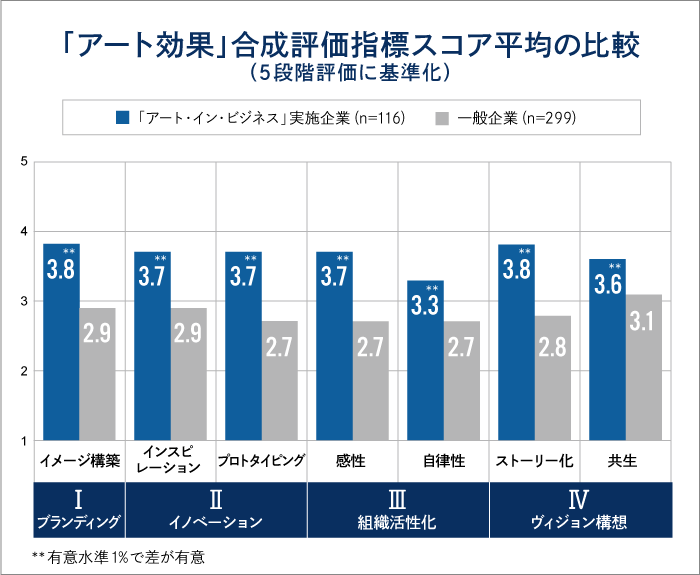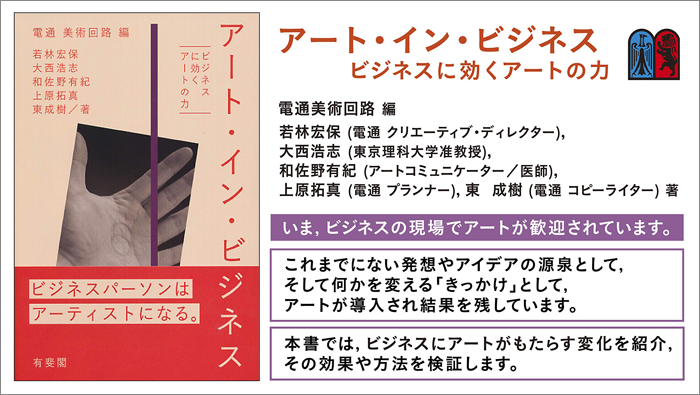Hello, I'm Hiroshi Onishi, a member of Bijutsu Kōro (※1). My primary role is as a faculty member in the Faculty of Business Administration at Tokyo University of Science, specializing in marketing analysis using online data.
This series, "Art in Business: The Front Lines," explores the theme "Does Art Work in Business?" In Part 1, we explained the mechanisms by which art generates effects in business, as proposed in our book Art in Business: The Power of Art That Works in Business (Yuhikaku), using the keywords "Art Power" and "Art Effects." The second installment introduced the concept of "internalizing art," another key term, presenting practical business approaches that professionals should aim for, especially in today's climate, supported by case studies.
This third installment examines how the effects of art in business can be verified. We provide an overview of existing academic research and introduce our own quantitative survey-based approach to effect verification.
(※1) Bijutsu Kuroi (Art Circuit): An art unit supporting business creation that incorporates Art Power. Dedicated website
Empirical Research on Art's Effects in Business
This may get a bit academic, but organizing past empirical research on utilizing art in business reveals effects broadly categorized into three types (※2).
1. Art Infusion (Branding Effects)
2. Art-based management (Relationship/Organizational Activation Effects)
3. Artistic Intervention (Innovation Effect)
The first, "Art Infusion" (Branding Effects), falls under the academic research field known as the insertion effect of art. This research examines how companies can enhance communication effectiveness by utilizing artworks or artists in advertising and communications. In other words, incorporating art can help build a brand image for products and increase perceived value, yielding branding benefits.
Examples include luxury fashion brands collaborating with artists or supporting emerging talent through art awards. Interestingly, empirical studies show that practical, non-luxury products like soap or mineral water often demonstrate stronger effects when art is used in packaging design (*3).
The second area, "Art-based management" (relationship/organizational revitalization effects), researches how incorporating art can smooth communication within organizations and revitalize them. Empirical studies in this field have confirmed effects such as resolving inter-organizational conflicts, enhancing unity, and increasing work motivation. This occurs through artists conducting workshops for employees or employees collectively experiencing art.
However, while small organizations often see short-term effects, the impact on large organizations is frequently limited. Enhancing effectiveness requires building long-term organizational culture (*4).
The third is "Artistic intervention" (innovation effect), which focuses on artists deeply engaging within business. Also called the intervention effect of art, it has been extensively researched in recent years, primarily in Europe and the US, based on numerous practical cases. As the term suggests, artists participate in or intervene in corporate projects, stimulating employee inspiration and enhancing creativity.
In 2018, the academic journal Journal of Business Research published a special issue titled "The arts as sources of value creation for business: Theory, research, and practice," featuring approximately 20 research papers (※5). A common point highlighted across these studies is that for art interventions to succeed, the presence of a facilitator is key. This is because artists and businesses often have different ways of thinking and share only a limited common language, making the facilitator essential for mediating and facilitating communication between the two sides.
However, most of the academic research introduced above is based on case studies or interviews with a small number of participants. Studies that confirm the effects of art using large quantitative data sets are limited.
(※2) This is the author's own classification. Some existing research categorizes Art-based management and Artistic Intervention under the same category.
(※3) See Lee, Chen & Wang (2015) "The role of visual art in enhancing perceived prestige of luxury brands," Marketing Letters, 26; Huettl & Gierl (2012) "Visual art in advertising: The effects of utilitarian vs. hedonic product positioning and price information," Marketing Letters, 23; Hagtvedt & Patrick (2008) "Art infusion: the influence of visual art on the perception and Evaluation of Consumer Products," Journal of Marketing Research, 45(3), etc.
(※4) Berthoin Antal (2012) "Artistic Intervention Residencies and Their Intermediaries: A Comparative Analysis," Organizational Aesthetics, 1(1); Sutherland (2012) "Arts-based methods in leadership development: Affording aesthetic workspaces, reflexivity and memories with momentum," Management Learning, 44(1); Taylor and Ladkin (2009) "Understanding Arts-Based Methods in Managerial Development," Academy of Management Learning & Education, 8(1), etc.
(※5) Journal of Business Research (2018) "The arts as sources of value creation for business: Theory, research, and practice"
For a detailed review of the papers featured in this special issue, see Fumi Yaegashi, Satoshi Goto, Yuki Shigemoto, and Takuo Ando (2019), "Research Trends on the Utilization of Art in Business," Ritsumeikan Business Review, Vol. 58, No. 4.
Quantitatively Verifying the Effects of Art
Therefore, drawing on existing research, we undertook an effort to verify the "art effect" through quantitative surveys using extensive data. With the cooperation of three companies—Terada Warehouse, Monex Group, and Smiles—which implement art-related initiatives (Art in Business) and were also featured as case studies in the book, we conducted quantitative surveys of their employees from March to April 2019.
Simultaneously, we administered the same survey to employees at other general companies. By comparing these results, we analyzed the effects of art in business.
The most clear-cut result, and one that surprised us, was that employees at the three companies implementing Art in Business outperformed employees at general companies in the average composite evaluation score across all business effects of art, including branding, innovation, and organizational revitalization.
Specifically, regarding the fourth art effect newly added in this book, "Vision Formulation," we were able to verify effects such as Terada Warehouse continuously generating new art-related businesses and Smiles fostering a corporate culture where employees and stakeholders plan and implement new businesses as their own initiatives.
These companies have engaged in long-term art-related initiatives. As introduced in the second installment of this series, their employees have progressively "internalized art," and these efforts have yielded effects that employees themselves perceive and value as tangible business outcomes.
The book provides a more detailed analysis of quantitative survey data, examining how the "Art Power" concept explained in the first installment correlates with "Art Effects," and also analyzes the extent to which Art in Business contributes to organizational culture and workplace well-being.
That said, this quantitative survey represents only the first step in answering the broader question: "Does art work for business?" Moving forward, we intend to deepen our verification efforts, continuing to use quantitative surveys as our core approach while seeking the cooperation of all those interested in verifying the effects of art in business.





